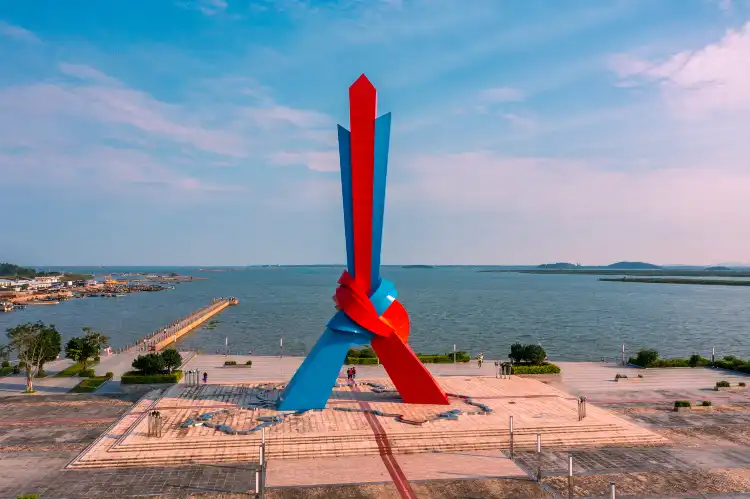
Descubra sua estadia em Dongxing
Insira as datas de viagem para verificar a disponibilidade e os preços atualizados
Deslize para cima para ver mais
Filtrar por:
Classificação de hotéis por estrelas
≤2345
Filtros mais utilizados
Incrível 4,5+Ótimo 4.0+Bom 3.5+Agradável 3.0+Encontramos 436 hotel para você em Dongxing
Escolha suas datas de viagem para ver os preços atualizados.
Mais escolhido
Preço mais baixo
Mais próximo do centro da cidade
Melhores avaliações

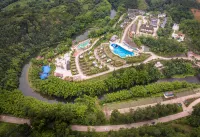

Hotel próximo a Dongxing
AAnonymous User 2023.05.27
Very good place, very quiet at night, the bedding is very comfortable, sleep very well, get up in the morning, open the window is birds and flowers, the air is very clear, the villa is very large, there is a swimming pool, you can go swimming, and there is a restaurant, just met a guest roasting sheep, they shared some with me, Very delicious, next time I come here for team building, there is a river, see a lot of fish, the environment is really impeccable. There are a lot of fruit on the mountain, and I will droole when I look at it. In short, this holiday is very comfortable and I will recommend more friends to come and play. The service here is great!
Excellent
57 avaliações
4.4/5
Preço a partir de
R$ 124
por noite



Hotel próximo a Golden Beach on Wanwei Island,Dongxing 100% dos visitantes escolhem essa área
Qqer413 2023.07.11
There is one thing to say, when I went, I was actually still renovating. At a more affordable price, let me talk about the location of the hotel first: the location is relatively superior, you can't see the sea, but the location is quiet, you can walk to the muddy sea in ten minutes. The swimming pool behind the hotel is not open, it has not been cleaned up, and the woods next to it have no lights at night, completely dark.
Room: The room size is right, the facilities are average, and the mattress is comfortable. The door has no chain and the psychological feeling is a bit uneasy. The bathroom is generally hygienic, the glass water stains are obvious, the glass glue that is partitioned is all moldy, and sometimes the sewer will have a smell. The toilet was not cleaned. The floor of the room may not be cleaned because of the decoration.
Facilities: The hotel elevator is rotten. In fact, I should say that I have never seen this new and old hotel. The renovation is a fact, but many places are still in tatters. Two breakfasts for more than 100 yuan accommodation fee are ordinary Chinese staple breakfasts: steamed buns fritters porridge fried noodles, boiled egg soy milk, and two stews, full. The hotel corridor is tiled, and it is especially loud if someone drags luggage in the morning.
The service staff is very friendly.
65 avaliações
3.5/5
Preço a partir de
R$ 94
por noite
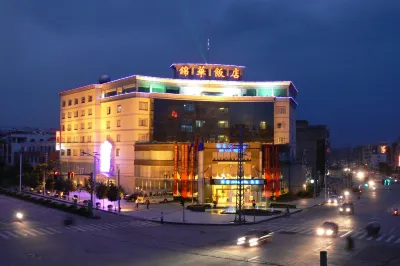
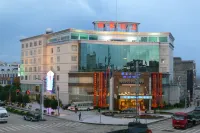
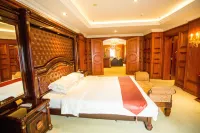
Hotel próximo a Dongxing
2024.02.15
The environment is clean and hygienic. I found that the toilet door was locked in the middle of the night. There is also a public toilet on the same floor. I contacted the service desk in the morning to unlock it and quickly helped solve it.
36 avaliações
3.2/5
Preço a partir de
R$ 167
por noite

Talvez você prefira
Hotéis com café da manhãHotéis com quarto twinHotéis com 1 cama de casalHotéis com piscinaHotéis com cancelamento grátis
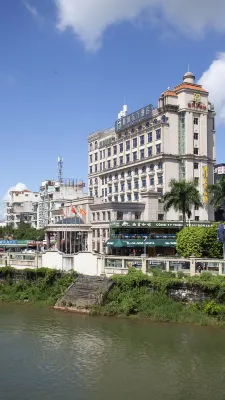

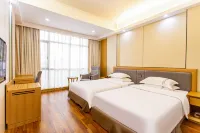
Hotel próximo a Dongxing
GGuest User 2024.10.09
The hotel can be seen to be old, and the facilities are a bit older. There is an observation deck next door. The hotel also has an observation deck, but it is relatively simple. You can also enjoy the scenery from the hotel's sightseeing elevator. There is parking downstairs, but there were too many people in the afternoon, so it was difficult to drive there, and people blocked the driveway.
The breakfast at the hotel is average. There is nothing to eat except noodles. There is Saigon Coffee downstairs, the pedestrian street when you go out, and the border crossing next to it. It is better because of the location.
Excellent
646 avaliações
4.3/5
Preço a partir de
R$ 128
por noite

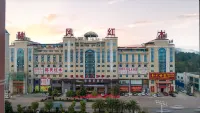

Hotel próximo a Dongxing
GGuest User 2024.02.28
Yoyo's room is comfortable and I particularly like the decoration style. It's clean and tidy, and the details are in place. The service attitude of the waiters is very good. It's very heart-warming. It's cost-effective and worth staying. It's easy to get in and out.
Outstanding
298 avaliações
4.7/5
Preço a partir de
R$ 103
por noite

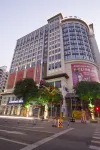

Hotel próximo a Dongxing
AAnonymous User 2024.02.14
It is close to the national gate scenic area and convenient for travel. The downside is that it is close to the KTV and you can hear it even if the window is closed at 2 o'clock!
Excellent
572 avaliações
4.4/5
Preço a partir de
R$ 159
por noite

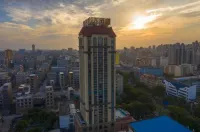
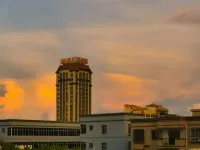
Hotel próximo a Dongxing
GGuest User 2024.03.05
This hotel is next to the police station, which makes it feel very safe. It is far from the port, and there are plenty of parking spaces, but there are many shared bicycles at the door. Dongxing is very small, and you can ride around for three or four yuan.
The room is fully intelligent, and my daughter likes to use Xiaodu to control the facilities in the room. See Figure 1 for breakfast, and Figure 2 is a book introducing Dongxing in the room.
I feel that the 200 surprise room is very surprising, and they will take the initiative to ask us if we want a double room or a double bed room. At this price, I feel that this hotel with this configuration is worth it. If it is placed in a big city, it will cost seven or eight hundred per night.
Outstanding
812 avaliações
4.7/5
Preço a partir de
R$ 118
por noite



Hotel próximo a Dongxing
GGuest User 2023.12.17
Complete facilities, good service, large rooms, and convenient parking. The rooftop has a view of Beilun River👍👍
38 avaliações
3.6/5
Preço a partir de
R$ 107
por noite



Hotel próximo a Dongxing
GGuest User 2024.07.22
The room is very spacious and quiet at night. The floor-to-ceiling windows provide good lighting and are very cost-effective. The bathroom is very large. The self-service laundry room is on the 8th floor. There are not many people and there is no need to queue.
Excellent
350 avaliações
4.5/5
Preço a partir de
R$ 81
por noite



Hotel próximo a Dongxing
GGuest User 2024.10.15
Especially the mattress, which is very comfortable to lie on and has good sound insulation. Even if you are tired after a day of playing, you can lie down and sleep without any noise! The front desk and waitress are also very nice and speak very softly!
Outstanding
109 avaliações
4.8/5
Preço a partir de
R$ 136
por noite
Principais escolhas de hotéis adorados pelos viajantes em Dongxing
Ver tudo
Escolha dentre estes hotéis, que foram os mais reservados do mês passado
No.1
4.7/5
1350 avaliaçãoVienna International Hotel (Dongxing Port)
Hotel em Dongxing
"Large rooms""Convenient parking"
Selecione as datas para ver os preçosNo.2
4.7/5
1568 avaliaçãoRamada Plaza by Wyndham Dongxing Citycenter
Hotel em Dongxing
"Great view""Delicious breakfast"
Selecione as datas para ver os preçosNo.3
4.6/5
506 avaliaçãoKelly Smart Choice Hotel (Dongxing Guomen Port)
Hotel em Dongxing
"Convenient location""Great value for money"
Selecione as datas para ver os preçosNo.4
4.6/5
396 avaliaçãoGerman Hotel (Dongxing Port)
Hotel em Dongxing
"Convenient location""Convenient parking"
Selecione as datas para ver os preçosNo.5
4.2/5
162 avaliaçãoHaotai Hotel (Dongxing Port)
Hotel em Dongxing
"Convenient location""Great value for money"
Selecione as datas para ver os preçosNo.6
4.1/5
92 avaliaçãoDongxing Hongguan Hotel
Hotel em Dongxing
"Great stay!""Great rooms"
Selecione as datas para ver os preçosNo.7
4.7/5
638 avaliaçãoMagnotel Hotel (Dongxing Guomen Port)
Hotel em Dongxing
"Convenient location""Convenient parking"
Selecione as datas para ver os preçosNo.8
4.4/5
51 avaliaçãoXingmu Inn (Dongxing Port)
Hotel em Dongxing
"Clean and tidy""Classy environment"
Selecione as datas para ver os preçosNo.9
4.6/5
114 avaliaçãoDongxing Jinhuilong Meisu (Port Branch)
Hotel em Dongxing
"Large rooms""Great design"
Selecione as datas para ver os preçosNo.10
4.5/5
195 avaliaçãoPinshangjin Hotel Dongxing international trade port store
Hotel em Dongxing
"Convenient parking""Convenient location"
Selecione as datas para ver os preçosDesperte com um delicioso café da manhã em Dongxing
Ver tudo
Comece o seu dia com um delicioso café da manhã em um dos hotéis mais procurados desta cidade
Vienna International Hotel (Dongxing High-speed Railway Station)
Hotel em Dongxing
The Vienna International Hotel (Dongxing High-speed Railway Station) provides a great place for travelers to relax after a busy day. Visitors to Dongxing will find that the Vienna International Hotel (Dongxing High-speed Railway Station) is a fantastic accommodation choice. The hotel is conveniently located a short 15km drive from Dongxingshi Railway Station. Seeing Dongxing's sights from this hotel is easy with Ho Chi Minh Pavilion, Sino-Vietnam Friendship Bridge and Yuenan Street all close by. This hotel makes a great place to kick back and relax after a long day of sightseeing. This Dongxing hotel offers parking on site. According to our trusted guests, the facilities at this hotel are first-rate. This hotel is particularly popular with those traveling with friends.
4.7/5
Outstanding279 avaliaçãoPreço por noite a partir de: BRL 152
Dong Run Hotel
Hotel em Dongxing
The Dong Run Hotel is an ideal spot for travelers wanting to discover the city. Visitors to Dongxing will find that the Dong Run Hotel is a fantastic accommodation choice. After a long day of sightseeing, guests can retire to the comfort of the hotel. Guests of this Dongxing hotel can make use of the parking facilities.
5.0/5
Perfect28 avaliaçãoPreço por noite a partir de: BRL 123
South Asia Hotel
Hotel em Dongxing
The South Asia Hotel is an ideal spot for travelers wanting to discover the city. Visitors to Dongxing will find that the South Asia Hotel is a fantastic accommodation choice. In terms of transportation, Dongxingshi Railway Station is approximately 19km away. Dongxingshi Railway Station is approximately 19km away by road. Famous local attractions Sino-Vietnam Friendship Bridge, Hongqi Street and Yuenan Street, can all be reached with a short walk. In their spare time, guests can explore the hotel's surroundings. This Dongxing hotel features parking on site.
4.3/5
Excellent82 avaliaçãoPreço por noite a partir de: BRL 110
GreenTree Inn
Hotel em Dongxing
The GreenTree Inn is a great choice for guests looking for accommodation in Dongxing, having been recently opened in 2021. The hotel is located approximately 17km from Dongxingshi Railway Station. The nearest railway station is Dongxingshi Railway Station, approximately 17km away. There's plenty to do nearby, with Ho Chi Minh Pavilion, Baihe Mountain Reservoir and Port of Dongxing all within a short distance. This hotel makes a great place to kick back and relax after a long day of sightseeing. This Dongxing hotel offers parking on site. Our guests rate this hotel as one of the best hotels for cleanliness. For guests traveling with families, this hotel is consistently one of the most popular choices.
4.5/5
Excellent309 avaliaçãoPreço por noite a partir de: BRL 98
Echarm Hotel (Dongxing Minzu Road)
Hotel em Dongxing
The Echarm Hotel (Dongxing Minzu Road) provides a great place for travelers to relax after a busy day. The Echarm Hotel (Dongxing Minzu Road) is an ideal choice for travelers who want to take in the sights and sounds of Dongxing. Dongxingshi Railway Station is the closest major transportation option, approximately 16km away. Traveling to and from the railway station is easy with Dongxingshi Railway Station located approximately 16km away. Guests will find Boundary Monument No.5 in the Great Qing Dynasty, Port of Dongxing and Dongxingwaitan Park just a short distance from the hotel. In their spare time, guests can explore the hotel's surroundings. Guests of this Dongxing hotel can make use of the parking facilities. There's never a dull moment at this hotel, our guests indicate that the facilities are excellent. This hotel is particularly popular with those traveling with friends.
4.7/5
Outstanding336 avaliaçãoPreço por noite a partir de: BRL 163
Hotel Neo, Dongxing
Hotel em Dongxing
Located in the prosperous zone of the International Trade Center in Dongxing, Guangxi, the NEO-Dongxing port hotel is located in a convenient location and convenient transportation. It is about 2 minutes'drive from Dongxing, Guangxi bus terminus, 100 meters straight on pedestrian street, 300 meters at Dongxing port and 800 meters in immigration clearance hall. There are many scenic spots around: the Friendship Park between China and Vietnam, Foshan is about 5 minutes walking, and the Chen Mansion is about 10 minutes walking, it is adjacent to Jiangshan City Peninsula tourist resort, Shek Kok Mangrove area, List of National Parks of China, Zhushan, Florida, about 30 minutes by car. Bus 1,3 way through the hotel, ready to take you around the city every corner. Hotel wi-fi coverage, with luxury business room, luxury standard twin room, family room and other types of room, the hotel provides free toiletries, large parking, brand bathroom and other hardware facilities; First travel such as Home Neo-dongxing Port store adhering to the family has always been the "home" culture to do your work and travel in a trusted "home" !
4.3/5
Excellent184 avaliaçãoPreço por noite a partir de: BRL 111
Dongxing Huidu Hotel
Hotel em Golden Beach on Wanwei Island, Dongxing 100% dos visitantes escolhem essa área
The Dongxing Huidu Hotel provides a great place for travelers to relax after a busy day. The Dongxing Huidu Hotel offers a pleasant stay in Dongxing for those traveling for business or leisure. The hotel is located approximately 22km from Dongxingshi Railway Station. Dongxingshi Railway Station is approximately 22km away by road. Seeing Dongxing's sights from this hotel is easy with Wanwei Golden Beach, Dongxingjingzu Museum and Dongxing Jing Museum all close by. In their spare time, guests can explore the hotel's surroundings. This Dongxing hotel offers parking on site.
3.9/5
13 avaliaçãoPreço por noite a partir de: BRL 96
City Comfort Inn (Dongxing International Trade Port Store)
Hotel em Dongxing
The City Comfort Inn (Dongxing International Trade Port Store) is an ideal spot for travelers wanting to discover the city. Visitors to Dongxing will find that the City Comfort Inn (Dongxing International Trade Port Store) is a fantastic accommodation choice. From the hotel, Dongxingshi Railway Station is just 8km away. The nearby area boasts an abundance of attractions including China-Vietnam Friendship International Paradise, Guan Yu’s Temple and Ho Chi Minh Pavilion. In their spare time, guests can explore the hotel's surroundings. This Dongxing hotel offers parking on site. This hotel is particularly popular with those traveling on business.
4.5/5
Excellent196 avaliaçãoPreço por noite a partir de: BRL 95
Dongxing Ruyi Hotel
Hotel em Dongxing
The Dongxing Ruyi Hotel is one of the newest hotels in Dongxing, having been renovated in 2021. From the hotel, Dongxingshi Railway Station is approximately 15km away. Dongxingshi Railway Station is the closest option for those who prefer to travel by train, approximately 15km away. Seeing Dongxing's sights from this hotel is easy with Guanyin Temple, Dongxingwaitan Park and Ho Chi Minh Pavilion all close by. After a long day of sightseeing, guests can retire to the comfort of the hotel. Guests of this Dongxing hotel can make use of the parking facilities. There's never a dull moment at this hotel, our guests indicate that the facilities are excellent.
4.3/5
Excellent59 avaliaçãoPreço por noite a partir de: BRL 106
Hotel Kina Dongxing
Hotel em Dongxing
Opened in 2021, the Hotel Kina Dongxing is a great accommodation choice in Dongxing. From the hotel, Dongxingshi Railway Station is just 15km away. The nearby area boasts an abundance of attractions including Guanyin Temple, Dongxingwaitan Park and Guan Yu’s Temple. In their spare time, guests can explore the hotel's surroundings. For those driving themselves, parking is provided on site. Our guests rate this hotel as one of the best hotels for cleanliness.
4.4/5
Excellent75 avaliaçãoPreço por noite a partir de: BRL 73
Veja opiniões de outros viajantes sobre hotéis em Dongxing
Ver tudo
Confira avaliações genuínas e informações úteis de viajantes reais que ajudarão a encontrar a estadia perfeita para você
4.9/5
Perfect
GGuest User挺不錯的,大陽台還有停車位洗衣機。店主很不錯很熱情,適合雙人………… 位置不算偏剛剛好(。•̀ᴗ-)okjjj
4.7/5
Outstanding
GGuest UserThe homestay is better than the picture, very warm and clean, and also equipped with disposable towels and bath towels👍 There is a room that can be used as a parent-child room. A family of 6 people is just right. There are many Vietnamese specialties that are checked in by Internet celebrities around, recommended! I want to know how delicious and delicious to find a warm landlord sister.
4.6/5
Outstanding
KKai87It's a pretty good accommodation experience. The hotel is very close to the hospital. There are also several places to eat nearby. It's a bit far from attractions and bus rides. It's about 1 km away, which is within the acceptable range.
The hygiene is also good, no smell, and the cleaning is very timely. Because I live in a windowless room, the room is a bit damp.
The soundproofing is not very good. There was someone staying next door at 11pm, so I could hear the conversation clearly.
Overall, you get what you pay for.
4.6/5
Outstanding
GGuest UserThe homestay is very new and clean. The location is really a must-have. It takes 3 minutes to walk to the port flag street, and the shared bicycle is at the door of the hotel. It is really convenient to travel. The back door of the famous hotel is the Friendship Park, and the view is very good. The surrounding business is mature. The room details are also very warm and recommended. Next time I come here, I will choose here.
4.6/5
Outstanding
GGuest User#服務老闆娘很熱情,老闆娘人很好,到了酒店雖然很累看到她有問必答都是笑嘻嘻的樣子,人都會輕鬆很多,老闆娘比老闆(一個中年男人,不知道是不是老闆)會處事和與人交流,第二天退房,家裡老人笑嘻嘻的問那個男的哪個方向是國門方向,他有點桀驁不馴的懟老人,住9樓沒看見嗎?那麼漂亮都不知道?我在想,我們都看見漂亮,知道哪裡會問你嗎?作為遊客,不清楚肯定會詢問工作人員,況且也沒有看到漂亮的樣子,晚上8點過也是黑漆漆的一片星星點點一些燈,附近不是很熱鬧。也希望店家不要拒人以千裏之外,大家都是中國人!建議:希望這位男士也能像老闆娘學習,反正都要麪對你的客人,客人也是口碑還能介紹客源,可以熱情一點,不要那麼傲慢!提高口碑!#位置交通位置其實很好,離國門就走路大概20分鐘的樣子,路邊可以停車!#房間設施房間比較大,價格比較實惠,房間也比較乾淨,很貼心的有一個晾曬很多衣物的衣桿
4.5/5
Excellent
MMayulonglongI traveled alone from Beijing on National Highway 219 and stayed in Dongxing. This hotel is great, only 1 km away from the port. The front desk service was very good. They upgraded me to a deluxe king-size room for free. The shower head was very strong and the hair dryer was very powerful. It was a good experience.
4.5/5
Excellent
GGuest UserRoom hygiene, facilities, service is very satisfactory! The first time I went to Guangxi, this Jinghua Hotel is this time Fangchenggang, Dongxing City trip, the most satisfying hotel. Friends who come to Fangchenggang Dongxing City to play outside, rest assured to place an order and stay. The hotel also has a warm suite. Our group, friends and a family of suites, are also very happy. Next time you come to Dongxing to play, you must stay at this hotel. Thank you boss!
4.3/5
Excellent
CCAZAThe hotel proprietress warmly introduced the nearby Dongxing Port to be worth a visit. It can be reached in 20 minutes on foot. There are many attractions, and there are Vietnam Street Vietnamese style Street Vietnamese food street, etc., it is worth a visit.
4.0/5
Very Good
GGuest UserOld hotel, no towels, non water, non glasses to make a cup of tea, ... Smell room, bad air conditioner...maybe they are not ready to welcome guest at the ***** New Year holiday
3.8/5
GGuest UserThe boss is very welcoming, the room is very spacious, the floor is big, the transportation is convenient, there is a shared electric car at the door to guard the Public Security Bureau, safe.
O que os viajantes falam sobre as atrações de Dongxing
Descubra esses lugares que valem a pena visitar em Dongxing e selecione um hotel próximo para sua maior comodidade
Dong Xing Port
Bbinger1031Boundary monuments, Ho Chi Minh Pavilion, national gate... several iconic buildings are easy to find, and the rest is shopping. Things are indeed cheap, but they can all be bought online.
The towering national gate stands on the bank of the Beilun River, solemn and majestic, and the five-star red flag flies high to declare sovereignty. Just 100 meters away from the port is Mong Cai, Vietnam, and the China-Vietnam Friendship Bridge connects the two countries. There is a No. 5 boundary monument of the Qing Dynasty by the river, with the words "Qinzhou Boundary of the Qing Dynasty" engraved in the middle of the monument. Now it is no longer a real boundary monument, standing on the border line and becoming a cultural relic. The prosperity of border trade has brought prosperity to the city. Every street and every building looks very new, and there are no relics of the ancient city at all. There are shops on both sides of the street, and there are a variety of specialties. We strolled on the street, and there were endless pedestrians. Green canvas hats, pointed white hats... You can appreciate the culture and customs of foreign countries without leaving the country. Of course, I prefer the streets in the morning. Without the hustle and bustle, it has returned to its original appearance.
Wanwei Golden Beach
山山在穷游When you come to Bailang Beach, you have actually come to Wanwei Golden Beach, which is quite large. Walking from one end to the other, I can feel the beauty of the beach and the changes of the beach. I can see many small crabs crawling on it and a small dead fish lying on it. Local fishermen said that they will go to the other end of the beach to catch squids at night. This is my favorite activity.
Yuenan Street
郭郭润龙浪迹天涯20230615 afternoon:
1. "National Gate Three Streets" is located in the 4A scenic spot "Dongxing National Gate". Dongxing National Gate is a land port connecting Fangchenggang City, Guangxi Province and Mong Cai, Vietnam. It was established in 1958 and is an important trading port between China and Vietnam. It has more than 3 million people entering and leaving the country each year, ranking third among all land ports in the country and first in Guangxi Province. It was once used as an export channel for aid to Vietnam. It was closed in 1978 due to the Sino-Vietnamese self-defense counterattack and reopened in 1994. Chinese and Vietnamese residents traveled between China and Vietnam through the "Sino-Vietnamese Friendship Bridge" across the Beilun River. The center line of the Beilun River is the border between the two countries.
① Address: No. 63, Zhongshan Road, Dongxing City, Fangchenggang City, Guangxi Province.
② Transportation: Direct bus, but you have to walk 1.1 kilometers after getting off. It is easy to park by car.
③ Peak season: None.
④ Time: 2 hours.
2. Customs clearance precautions:
① You cannot take photos when entering the port indoors.
② Do not help strangers to carry things through customs: if something goes wrong, it will be considered smuggling at the least, and if there are drugs in it, the consequences will be disastrous.
③ Prohibited items: animals, plants, fruits, seeds, audio tapes, video tapes, etc. These are the most easily neglected. I won’t mention other well-known contraband.
④ When passing through customs, put down the new version of your passport at the first gate (the new version of the passport has a camera symbol under the "passport" on the cover) for scanning, and the countdown is 10 seconds. Go to the manual channel with the old version of your passport; scan your face at the second gate.
⑤ There is a very small probability that some people will be randomly checked for baggage inspection.
3. The Sino-Vietnamese Friendship Bridge is located between the Chinese port and the Vietnamese port. It was built in the 24th year of the Guangxu period of the Qing Dynasty (1898). It is an iron bridge jointly built by China and France, making the Dongxing Port a prosperous place for business. After the iron bridge was scrapped in 1957, it was rebuilt into a stone bridge the following year and named "Beilun River Bridge". It is 111 meters long. In 1960, when Tao Zhu, then the first secretary of the Guangdong Provincial Party Committee, inspected the bridge, he changed the name of the bridge to its current name and inscribed the name of the bridge. The two words "Friendship" added reflected my country's good expectations for Sino-Vietnamese relations. However, things did not go as planned. During the Sino-Vietnamese self-defense counterattack in 1978, the Vietnamese side blew up the bridge. After the restoration of diplomatic relations between China and Vietnam in 1992, the bridge was rebuilt with funds from China. Residents walking on the Friendship Bridge are "out of the country" for China and "not in" for Vietnam. Their identities at this time are very strange.
4. The three national gate streets refer to the three port pedestrian streets, Jianshe Street, Mulan Street, and Diandian Street. Many buildings on the streets were built during the Republic of China period, and there are both Chinese and Vietnamese goods in the shops.
Dong Xing Guo Men Scenic Area
山山在穷游Dongxing Guomen Scenic Area is a very large and general attraction. There are both Guomen, many boundary monuments, and some ancient buildings that have been left at the time. When we come here, we can visit the park and remember the martyrs. Is a nice border city attraction, the main thing is that these things are free
Dongxing Jingdao Scenic and Historic Interest Area
行行走毛毛How big is the Jingdao scenic spot in Dongxing? Actually, you will find out after you come. The entire Wanwei Golden Beach is in the Jingdao Scenic Area, but it may be affected by the epidemic in the past two years. The economy of the entire Qingdao Scenic Area is not very good. You will find that the very luxurious homestays built in the past are no longer operated. I believe that with such beautiful natural scenery, it will soon be better.
Boundary Monument No.5 in the Great Qing Dynasty
山山在穷游When you come to Dongxing, you must see the national gate. At the same time, you must also see the No. 5 boundary marker of Qinzhou, the Qing Dynasty. There are actually several boundary markers here, and this boundary marker is the most famous, and it is also framed with glass. It is actually on the roadside. You can see it when you take a walk here in the early morning. There is still a certain difference between looking at the ancient boundary markers and looking at our current ones.
No.1 Boundary Monument of Qing Dynasty
中中西南北东In the eleventh year of Qing Guangxu (1885), the Qing government and France signed the Treaty of China-France Vietnam in Tianjin. The following year (1886), the Qing government sent a member to the French envoy Dillon to explore the border between China and Vietnam. In the 16th year of Qing Guangxu (1890), the Qinzhou Zhifu and French officials signed the "border covenant", and the stone covenant was established here, so it is called "the border monument of the Qing Dynasty No. 1". The "border monument" is a symbol of the motherland's mother's vicissitudes. In fact, the border monument is surrounded by Chinese territory. It is a few tens of meters away from the boundary monument, which is the Beilun River. The real border between China and Vietnam is in the middle of the Beilun River, where it is naturally not suitable for the construction of the boundary monument. So, this boundary monument is only an "indicative" role, not a "defining" role. On the other side of the river, Vietnam's land, there is also a boundary monument erected by Vietnam, and that boundary monument also plays an "instruction" role.
China-Vietnam Friendship International Paradise
郭郭润龙浪迹天涯20230615 Afternoon: 1. The "China-Vietnam People's Friendship Park" is located at the "Dongxing Guomen" of the 4A scenic spot, which is the boundary river between China and Vietnam. Dongxing Guomen is a land port connecting Fangchenggang City in Guangxi Province and Mang Street in Vietnam. It was established in 1958 and is an important commercial port between China and Vietnam. It has more than 3 million people entering and leaving each year. It ranks third in all land ports in the country and first in Guangxi Province. Once an export channel for aid to Vietnam, it was closed in 1978 due to the Sino-Vietnamese self-defense counterattack, and reopened in 1994. The residents of China and Vietnam traveled to and from China and Vietnam through the "China-Vietnam Friendship Bridge" across the Beilun River, and the central line of the Beilun River was the national border of the two countries. ① Address: No. 63 Zhongshan Road, Dongxing City, Fangchenggang City, Guangxi Province. ② Transportation: Direct bus access, but you have to walk 1.1 kilometers to get off the bus. It is easy to stop by car. ③ peak season: no. ④ Time: 2 hours. 2. Concerns: ① You can't take pictures when you enter the port room. ② Don't help people who don't know to pass things: If something happens, lightness constitutes smuggling, and if there is drugs in it, the consequences are unimaginable. ③ prohibited items: animals, plants, fruits, seeds, audio tapes, videotapes, etc., these are the most vulnerable to neglect, and other well-known contrabands are not much to say. ④ When passing the customs, the first gate put down the new version of the passport (the new version of the passport with a camera symbol under the passport cover "passport") and scan it, countdown to 10 seconds. Take the old version of the passport to the artificial channel; the second gate brushes the face. ⑤ There is a very small probability that someone else will open the package for inspection. China-Vietnam People's Friendship Park: Founded in 1958 and rebuilt in 2000, the central center stands a towering monument to commemorate the soldiers who died when China aided Vietnam in the Vietnam War in 1954. The park also houses two friendship trees presented by Ho Chi Minh in 1960 and the tomb of Chen Handong martyrs (he died in the fight against Japanese guerrillas in 1945, and was reburied on the hillside in 1959 with five other martyrs).
Perguntas frequentes sobre Dongxing
Quais são os hotéis mais procurados em Dongxing?
Há muitos hotéis bastante procurados em Dongxing. Esteja você viajando a negócios ou de férias, Vienna International Hotel (Dongxing Port), Ramada Plaza by Wyndham Dongxing Citycenter e Green Oriental Hotel (Dongxingguo Branch) estão entre os hotéis preferidos. Qual é a tarifa média de hotéis em Dongxing?
Para hotéis em Dongxing, o preço médio durante a semana é de R$ 184, o preço médio nos fins de semana (sexta a sábado) é de R$ 188.Quais hotéis em Dongxing oferecem café da manhã de alta qualidade?
Vienna International Hotel (Dongxing Port),Ramada Plaza by Wyndham Dongxing Citycenter e Green Oriental Hotel (Dongxingguo Branch) oferecem café da manhã de alta qualidade. Comece seu dia com um delicioso café da manhã!Quais hotéis em Dongxing são recomendados para viajantes com crianças?
Vienna International Hotel (Dongxing Port), Ramada Plaza by Wyndham Dongxing Citycenter e Green Oriental Hotel (Dongxingguo Branch) são muito adequados para viagem em família. Desfrute de uma viagem com seus filhos e outros membros da família!Quais hotéis em Dongxing oferecem academia?
Vienna International Hotel (Dongxing Port), Ramada Plaza by Wyndham Dongxing Citycenter e Kelly Smart Choice Hotel (Dongxing Guomen Port) oferecem academia. Você pode fazer seus exercícios físicos mesmo durante a viagem.Quais hotéis em Dongxing permitem animais de estimação?
Yicheng Express Hotel (Dongxing Daping Branch), Dongxing Huaxing Express Hotel e Dongxing Port Yixin Homestay permitem animais de estimação. Leve seus animais de estimação na sua estadia!Quais hotéis em Dongxing possuem piscina?
Vienna International Hotel (Dongxing Port), Ramada Plaza by Wyndham Dongxing Citycenter e Kelly Smart Choice Hotel (Dongxing Guomen Port) são hotéis com piscina. Hospede-se em qualquer um desses hotéis e aproveite a piscina!Quais hotéis em Dongxing oferecem Wi-Fi gratuito?
Seja uma viagem a negócios, seja de férias, boa conexão de internet é uma condição essencial para viajar. Vienna International Hotel (Dongxing Port), Ramada Plaza by Wyndham Dongxing Citycenter e Green Oriental Hotel (Dongxingguo Branch) são hotéis muito procurados com wi-fi gratuito. Quais hotéis em Dongxing oferecem serviços de transporte de/para o aeroporto?
Não conhece bem Dongxing? Vienna International Hotel (Dongxing Port), Ramada Plaza by Wyndham Dongxing Citycenter e Kelly Smart Choice Hotel (Dongxing Guomen Port) oferecem serviços de transporte de/para o aeroporto. Quais hotéis em Dongxing oferecem spas que valem a pena conhecer?
Teve uma viagem cansativa? Vienna International Hotel (Dongxing Port), Ramada Plaza by Wyndham Dongxing Citycenter e Green Oriental Hotel (Dongxingguo Branch) oferecem serviços de spa muito bem avaliados. Quais promoções de hotéis estão valendo para Dongxing?
O Trip.com oferece várias promoções e descontos para usuários durante todo o ano. Você pode acessar a página de promoções para conferir quais promoções estão disponíveis no Trip.com.Informações sobre viagens locais
| Maior preço | R$ 1.113 |
|---|---|
| Menor preço | R$ 44 |
| Quantidade de avaliações | 23,486 |
| Quantidade de hotéis | 910 |
| Preço médio (dias úteis) | R$ 184 |
| Preço médio (fins de semana) | R$ 188 |